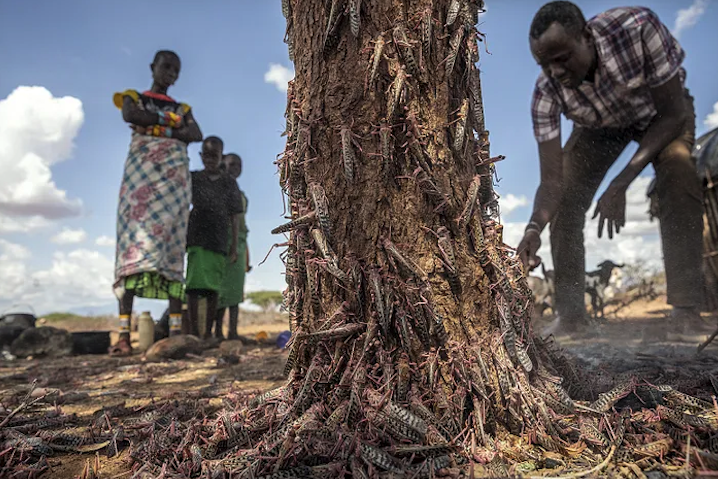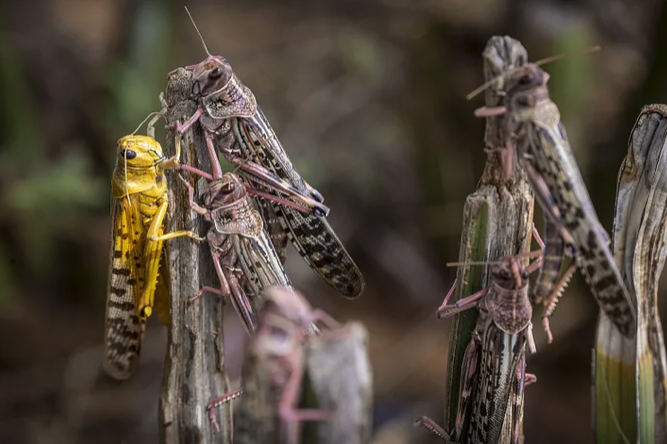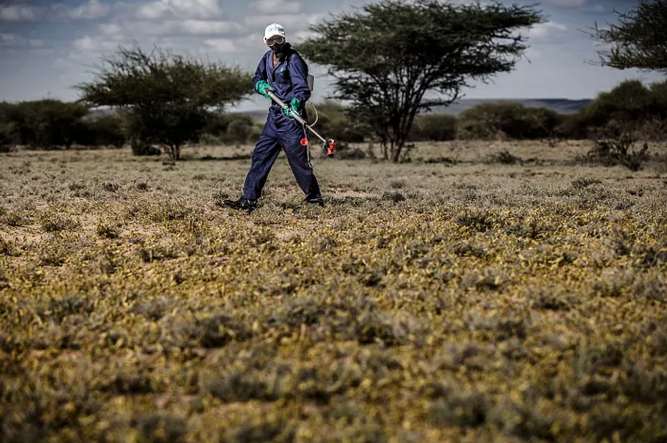From Crisis to Innovation: Learning from the Previous Desert Locust Invasions
How we can develop strategies to safeguard our food security and ecological balance
by Elena Lazutkaitė, and Emily Kimathi with contribution from the ICPAC Climate Change Technical Working Group | 2024-11-27

The 2019–2021 desert locust outbreak devastated the Horn of Africa, resulting in billions of dollars in damages. While toxic pesticides left environmental harm, eco-friendly innovations like biopesticides and advanced early warning systems emerged. Experts now call for integrating pest threats into climate resilience strategies.
Desert locust outbreaks are spectacular natural phenomena of extraordinary adaptation, and an essential part of food chain in arid and semi-arid landscapes. Yet when outbreaks occur on a large-scale, they can devastate agriculture in countries already on the frontlines of climate change. The desert locust upsurge from 2019 to 2021 was one of the most severe in decades, causing widespread destruction of crops and pastures across the Horn of Africa, worsening the region’s food insecurity. The crisis sheds light on the complex interplay between human actions, climate change, and environmental outcomes, offering important lessons for the future.
The Horn of Africa, covering 5.2 million square kilometers and home to 282 million people, is increasingly vulnerable to extreme weather events. This is particularly evident in the region's arid and semi-arid lands, where small-scale agriculture and livestock are the primary sources of livelihood. Unusually heavy rains, driven by cyclones in the warming Indian Ocean, created favourable breeding conditions for the desert locusts. These ideal conditions enabled the locusts to multiply exponentially, causing swarms to develop and spread across countries such as Kenya, Ethiopia, Somalia, and Sudan.
While the upsurge was driven by climatic conditions, human factors played an important role for its escalation into a full-blown regional crisis. Local and regional control efforts were overwhelmed, even with international support and emergency interventions. The situation was further complicated by the COVID-19 pandemic, which disrupted supply chains, delayed pesticide deliveries, and restricted personnel movement.

©FAO: Sven Torfinn
The Toll of Desert Locusts
Smallholder farmers and pastoralists, already struggling from recurring droughts, and conflict, faced devastating losses in crops and shortages of livestock feed due to the upsurge. The economic impact on the region has been staggering. According to World Bank estimates, damages and losses from the desert locust upsurge in East Africa and Yemen could amount to as much as USD 8.5 billion in 2020 alone, roughly 5 percent of the region’s total GDP. This figure could be even higher, as there is no robust methodology to capture the full extent of agricultural damage and its cascading effects on communities.
Moreover, these estimates do not take into account the human health risks and environmental consequences tied to the large-scale use of hazardous pesticides deployed in response to the crisis. This reliance on toxic broad-spectrum pesticides, while effective in the short term, poses significant environmental and public health risks that are increasingly difficult to ignore. During the 2019-2021, an estimated 2 million litres of chemical pesticides of organophosphate and pyrethroid groups were sprayed to control locust swarms across the region. The “collateral damage” of these interventions includes soil and water contamination and the disruption of non-target species like honeybees, fish and birds. Our research has shown that in Ethiopia, organophosphate pesticide spraying against locusts coincided with a honey production decline of 78 percent in 2020 compared to pre-upsurge levels. While there has been no systematic monitoring, in Kenya, reports indicate that bird populations have been decimated, while field workers and farmers have reported health issues following pesticide exposure.

©FAO: Sven Torfinn
Another pressing issue is the management of obsolete pesticides and the disposal of empty pesticide containers, a challenge that has become increasingly significant across the Intergovernmental Authority on Development (IGAD) region, after the 2019-2021 desert locust upsurge. The widespread use of these chemicals has resulted in the accumulation of obsolete stockpiles and large numbers of empty containers. As these chemicals age or become banned due to safety concerns, they become contamination hazards, and the improper disposal of containers only heightens environmental and health risks. Without sufficient infrastructure for safe disposal, communities repurpose these containers for storing water or food, exposing themselves to toxic residues.
The global conversation on pesticide use is gaining momentum. In September, the 20th meeting of the Chemical Review Committee of the Rotterdam Convention recommended chlorpyrifos, an organophosphate used for locust control, for inclusion in Annex III of the Convention, acknowledging its considerable risks to human health and the environment. Chlorpyrifos is already banned the EU and USA. Additionally, the Stockholm Convention, an international treaty aimed at eliminating or restricting persistent organic pollutants (POPs) has been assessing chlorpyrifos as part of its ongoing efforts to phase out hazardous chemicals that persist in the environment and accumulate in living organisms. Further decisions are forwarded to COP12 in 2025.

Hopper bands of desert locust infesting a farm in Nakukulas, Turkana County, Kenya on June 7, 2020, Nakukulas, Kenya. ©FAO/Luis Tato
The Importance of Early Warning Systems for Pests
The future of locust control hinges on two critical tools: early warning systems (EWS) and biopesticides. While the 2019-2021 locust upsurge caused widespread devastation, it also served as a catalyst for change. Notably, Somalia set itself apart by being the only country in the region to apply the biopesticide Metarhizium acridum. This selective biopesticide does not harm non-targets organisms, effectively protecting Somalia’s apiculture and pastoral livelihoods. The campaign demonstrated that an environmentally friendly pest control is not only feasible but within the reach.
The crisis also drove advancements in technology, particularly in the Desert Locust EWS of the Food and Agriculture Organisation on the United Nations, managed by the Desert Locust Information Service (DLIS) in Rome. Built on more than 50 years of experience, DLIS integrates a vast array of data, including geospatial datasets, historical ground observations dating back to the 1930s, remote sensing data, and rainfall forecasts. During the upsurge, 16 new innovations have been integrated into DLIS and national locust programmes to further improve monitoring, predictive modelling and early warning.
The affected region emerged as a beacon of innovation. Researchers such as Kimathi et al. (2020) harnessed the power of machine learning to predict desert locust breeding sites. By identifying key areas in Kenya, Uganda, South Sudan and Sudan based on environmental factors, these models provide vital early warnings. Such proactive measures are essential to safeguard agricultural livelihoods in vulnerable regions.

A member of Kenya’s NYS—National Youth Service—sprays pesticides in an area infested with hopper bands of desert locust near Lokichar, Turkana County, Kenya on June 7, 2020. ©FAO/Luis Tato.
Building on this momentum, the IGAD Climate Prediction and Applications Centre (ICPAC) in Nairobi, in collaboration with the German Aerospace Centre and TMG Research, a Berlin-based sustainability think tank, has initiated work on an East African Pest Watch prototype—a component of the broader East African Hazard Watch. This EWS aims to monitor and predict multiple pest activity, including desert locusts, across IGAD member states. By integrating climate data, satellite imagery, and ground observations, the initiative seeks to enhance regional forecasting capabilities, ultimately helping governments and organizations better prepare for potential pest outbreaks.
The 2019-2021 locust upsurge has exposed a critical gap in global agricultural policy: crop pests, though devastating, are still sidelined in early warning and disaster preparedness frameworks. Despite recent advances, pests like desert locusts largely fade from policy discussions once the immediate crisis subsides. Major early warning initiatives like Early Warning for All focus on climate and weather hazards, yet transboundary pest threats, closely linked to these same climate factors, fall outside their scope. Integrating pest risks into multi-hazard EWS frameworks would create a more comprehensive approach to safeguarding agriculture and livelihoods. With climate change already creating unprecedented environmental conditions, the locust crisis reminds us that our response must be equally transformative.
***
This article was originally published on IPAC's Medium account.
 Urban Food FuturesSep 29, 2025
Urban Food FuturesSep 29, 2025Cheaper food, higher costs: The paradox of Nairobi’s food systems
What are the hidden costs of foods sold in Nairobi's informal markets, and who must bear them? We discuss how the city could build food systems that are both affordable and fair—for consumers and the people who feed them.
Christian Sonntag, Emmanuel Atamba, Lumi Youm
 Land GovernanceJun 26, 2025
Land GovernanceJun 26, 2025Did 2024 - the year of the triple COP - change anything for land rights?
What did this “triple COP” moment really deliver for land rights? Can we keep the momentum up to advance gains made and push for bolder action?
Frederike Klümper
 Urban Food FuturesJun 20, 2025
Urban Food FuturesJun 20, 2025Working with informality: A hidden path to Zero Hunger
Global progress on Zero Hunger is faltering, but a powerful, overlooked solution exists: working with informality. Supporting the networks already feeding cities and sustaining communities can drive progress not only on hunger, but across multiple SDGs.
Jes Weigelt

